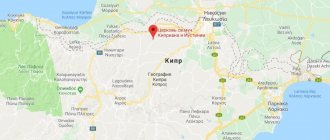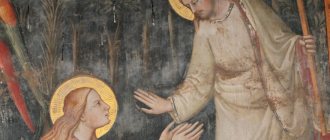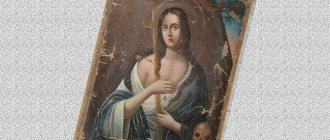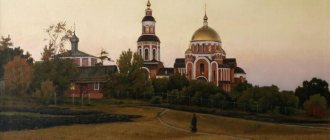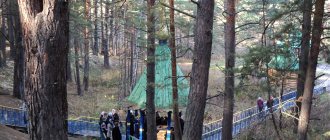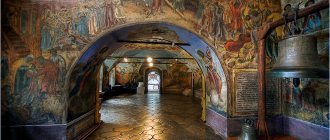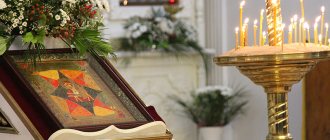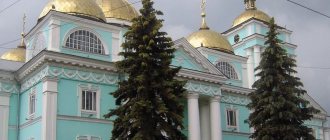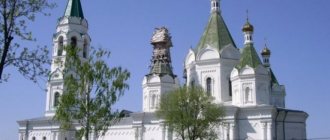Mir
Palestine Monastery of Mary Magdalene (Jerusalem) Map loading...
{"format":"leaflet","minzoom":false,"maxzoom":false,"limit":50,"offset":0,"link":"all","sort":[""], "order":[],"headers":"show","mainlabel":"","intro":"","outro":"","searchlabel":"\u2026 \u0441\u043b\u0435\ u0434\u0443\u044e\u0449\u0438\u0435 \u0440\u0435\u0437\u0443\u043b\u044c\u0442\u0430\u0442\u044b","default":"","import-annotation":false,"width ":"auto","height":"350px","centre":{"text":"","title":"""link":"""lat":31.778890000000000526370058651082217693328857421875,"lon": 35.2409499999999979991116560995578765869140625,"icon":""},"title":"","label":"","icon":"","lines":[],"polygons":[],"circles":[ ],"rectangles":[],"copycoords":false,"static":false,"zoom":8,"defzoom":14,"layers":["OpenStreetMap"],"image layers":[] ,"overlays":[],"resizable":false,"fullscreen":true,"scrollwheelzoom":true,"cluster":false,"clustermaxzoom":9,"clusterzoomonclick":true,"clustermaxradius":80, "clusterspiderfy":true,"geojson":"","clicktarget":"","showtitle":true,"hidenamespace":false,"template":"","userparam":"","activeicon": "","pagelabel":false,"ajaxcoordproperty":"","ajaxquery":"","locations":[{"text":"\u003Cb\u003E\u003Ca href=\"/palomnik/%D0% 9C%D0%BE%D0%BD%D0%B0%D1%81%D1%82%D1%8B%D1%80%D1%8C_%D0%9C%D0%B0%D1%80%D0%B8% D0%B8_%D0%9C%D0%B0%D0%B3%D0%B4%D0%B0%D0%BB%D0%B8%D0%BD%D1%8B_(%D0%98%D0%B5%D1 %80%D1%83%D1%81%D0%B0%D0%BB%D0%B8%D0%BC)\» title=\»\u041c\u043e\u043d\u0430\u0441\u0442\u044b\u0440\ u044c \u041c\u0430\u0440\u0438\u0438 \u041c\u0430\u0433\u0434\u0430\u043b\u0438\u043d\u044b (\u0418\u0435\u0440\u0443\u0441\u 0430\u043b\u0438\u043c)\ "" \u043b\u0438\u043d\u044b ( \u0418\u0435\u0440\u0443\u0441\u0430\u043b\u0438\u043c)\u003C/a\u003E\u003C/b\u003E\u003Chr /\u003E\u003Ca href=\"/palomnik/%D0%A1% D0%B2%D0%BE%D0%B9%D1%81%D1%82%D0%B2%D0%BE:%D0%90%D0%BD%D0%BD%D0%BE%D1%82%D0 %B0%D1%86%D0%B8%D1%8F\" title=\"\u0421\u0432\u043e\u0439\u0441\u0442\u0432\u043e:\u0410\u043d\u043d\u043e\u0442\u0430\ u0446\u0438\u044f\»\u003E\u0410\u043d\u043d\u043e\u0442\u0430\u0446\u0438\u044f\u003C/a\u003E: \u0436\u0435\u043d\u0441\u043 a\u0438\u0439\u0413 \u0435\u0444\u0441\u0438\u043c\u0430\u043d\u0441\u043a\u0438\u0439\u043c\u043e\u043d\u0430\u0441\u0442\u044b\u0440\u044c\ u0412\u0438\u0444\u0430\u043d \u0441\u043a\u043e\u0439 \u043e\u0431\u0449\u0438\u043d\u044b \u0412\u043e\u0441\u043a\u0440\u0435\u0441\u0435\u043d\u0438\ u044f\u0425\u0440\u0438\u0441 \u0442\u043e\u0432\u0430. \u042e\u0440\u0438\u0441\u0434\u0438\u043a\u0446\u0438\u044f: \u0420\u0443\u0441\u0441\u043a\u0430\u044f \u043f\u0440\u0430 \u0432\u043e\u0441\u043b\ u0430\u0432\u043d\u0430\u044f \u0446\u0435\u0440\u043a\u043e\u0432\u044c \u0437\u0430\u0433\u0440\u0430\u043d\u0438\u0446\u0 435\u0439","title":" \u041c\u043e\u043d\u0430\u0441\u0442\u044b\u0440\u044c \u041c\u0430\u0440\u0438\u0438 \u041c\u0430\u0433\u0434\u0430\u043b\ u0438\u043d\u044b (\u0418\ u0435\u0440\u0443\u0441\u0430\u043b\u0438\u043c)","link":"","lat":31.778890000000000526370058651082217693328857421875,"lon":35.240949 9999999979991116560995578765869140625,"icon":""}],,"imageLayers": []}
31.776588; 35.241582
Palestine, East Jerusalem, Mount of Olives
Palestine
Telephone
: 972-2 / 628-4371
Monastery of St. Mary Magdalene
- Women's Gethsemane Monastery of the Bethany Community of the Resurrection of Christ. Jurisdiction: Russian Orthodox Church Outside of Russia.
History[[edit]h2>
The construction of a temple in memory of Empress Maria Alexandrovna was proposed by the head of the RDM in Jerusalem, Archimandrite Antonin (Kapustin). He also offered a site for the construction of a church on the slope of the Mount of Olives and soon, by the autumn of 1882, the land was purchased. Architect D. A. Grimm drew up the project and the church was founded on January 21, 1885. The construction project was carried out by the Imperial Orthodox Palestine Society under the supervision and direction of the construction of Archimandrite Antoninus. The work on the construction of the temple itself was carried out by famous Jerusalem architects Konrad Schick, and then George Frangia. Tsar Alexander III contributed 100 thousand rubles for the construction of the temple, his four brothers - 15 thousand each; Grand Duchess Maria Alexandrovna - 5 thousand rubles. The Patriarch of Jerusalem consecrated the temple on October 14, 1888 in the presence of Grand Dukes Sergei Alexandrovich and Pavel Alexandrovich and Grand Duchess Elizabeth Feodorovna.
In January 1921, the bodies of the martyred Grand Duchess Elizabeth Feodorovna and her cell attendant Varvara were buried in the church, delivered from Russia through China. The burial was performed by Patriarch Damian of Jerusalem.
In 1934, with the blessing of Metropolitan Anastasy (Gribanovsky), the Scot Maria (Robinson), who converted to Orthodoxy, founded a women's Orthodox community here in the name of the Resurrection of Christ, becoming its abbess. She settles with some of her sisters in the Russian part of the Garden of Gethsemane near the Church of St. Mary Magdalene, where little by little she manages to establish daily worship and establish monastic life.
The community organized a school for Orthodox Arab children, which still exists today.
In 1988, on the occasion of the centenary of the consecration of the Church of St. Mary Magdalene, the Gethsemane community was elevated to the rank of a monastery.
On the territory of the monastery there is a cave chapel in the name of the Passion of the Lord. Its consecration took place in 1998. The chapel, built in memory of the stay of the apostles Peter, James and John in the Garden of Gethsemane at the time of Jesus’ prayer before his arrest, is located in a grotto on the territory of the monastery.
Monastery of Mary and Magdalene
Source of information: Nun Mariam (Yurchuk)
Guide to the Holy City of Jerusalem Volume I Guide to the Holy Land Volume II Russian Spiritual Mission 2021. (These books can be ordered at our pilgrimage center)
On the western slope of the Mount of Olives, which is a continuation of the ancient Garden of Gethsemane, is the Gethsemane Monastery in honor of St. Mary Magdalene, belonging to the Russian Orthodox Church Outside of Russia of the Moscow Patriarchate. Its full official name: “Gethsemane Women's Community with the Church of St. Mary Magdalene." From the territory of the monastery there is a magnificent view of the Temple Mount and the now walled-up Golden Gate. The entire site is surrounded by greenery, the monastery buildings are surrounded by green alleys, picturesque courtyards, cleanliness and peaceful silence reign everywhere. In the center of the monastery stands, sparkling in the bright Jerusalem sun with the onions of its seven golden domes, a temple in honor of St. Equal to the Apostles Mary Magdalene. This magnificent temple, one of the best examples of Russian architecture, fits perfectly into the surrounding landscape, being the architectural dominant and decoration of the entire western slope of the Mount of Olives. The history of its construction and existence is closely intertwined with the history of three generations of the Romanov dynasty that reigned in Russia. The acquisition of a plot of land on this site and the construction of the temple were the result of a pilgrimage to the Holy Land in the spring of 1881 by the sons of Emperor Alexander II, Grand Dukes Sergei and Pavel Alexandrovich, and their cousin Grand Duke Konstantin Konstantinovich. The immediate reason for the pilgrimage was the tragic losses in the Royal Family: the death of Empress Maria Alexandrovna (May 22, 1880) and the assassination of Emperor Alexander II (March 1, 1881). Empress Maria Alexandrovna, the wife of Emperor Alexander II, due to poor health, was never able to fulfill her dream of a pilgrimage to Jerusalem, but she always remained the patroness and benefactor of the Holy Land. On the eve of the anniversary of her death, her youngest sons, Sergei and Pavel, set foot on the soil of Palestine for the first time. The idea of honoring the memory of the mother by building a memorial church in honor of her heavenly patroness St. Equal to the Apostles Mary Magdalene belonged to the then head of the Russian Spiritual Mission, Archimandrite Antonin (Kapustin). It was he who proposed it to the grand dukes and indicated the location of future construction. The plot of land at this location has an area of 10.1 thousand square meters. m was purchased in the fall of 1882 in the name of the Consul General in Jerusalem V.F. Kozhevnikov and later transferred to the name of the Russian government. The foundation stone of the temple took place on January 21. 1885. At the same time, a memorial inscription was installed: “This sacred temple in the name of the holy Equal-to-the-Apostles Mary Magdalene was founded by the will of the most pious Sovereign, Emperor Autocrat of All-Russia Alexander Alexandrovich and His August brothers, Grand Dukes Vladimir, Alexei, Sergius and Pavel Alexandrovich, in memory of the deceased mother in God their most pious Empress Maria Alexandrovna." The construction of the temple lasted three years and was carried out under the watchful supervision of Father Antonin himself. Significant sums for the construction were contributed by Emperor Alexander III, his four brothers and Grand Duchess Maria Alexandrovna, as well as many representatives of the court aristocracy. The author of the temple project was the Russian architect D.I. Grimm (1823-1898), and the work on its construction was carried out by famous Jerusalem architects - Konrad Schick and, later, George Frangia. During the construction of the temple, the remains of an ancient biblical road leading from their top of the Mount of Olives to the eastern gate of the Jerusalem Temple and ancient Hebrew tombs from the Second Temple era were discovered. The solemn ceremony of consecration of the temple was led by Patriarch Nicodemus of Jerusalem. It took place on the feast of the Intercession of the Mother of God on October 1, 1888 in the presence of the great princes Sergei and Pavel Alexandrovich and Grand Duchess Elizabeth Feodorovna, Russian and Greek clergy and more than 150 Russian pilgrims. The governor of Jerusalem, the Russian and Greek consuls and the naval crew of the Russian cruiser Kostroma were also present at the celebrations. Grand Duchess Elizabeth Feodorovna's pilgrimage to the Holy Land and visit to the memorial church in memory of Empress Maria Alexandrovna undoubtedly played a significant role in her decision to convert to Orthodoxy. There is evidence that Grand Duchess Elizabeth, struck by the holiness and beauty of the Holy Land, prophetically exclaimed in spiritual delight: “How I would like to be buried here!” By the providence of God it was arranged that now her relics rest in one of the best places in Jerusalem. After her martyrdom in the Alapaevskaya mine on July 18, 1918, her honorable remains, together with the remains of nun Varvara (Yakovleva), who voluntarily accepted martyrdom with her, were transported by Abbot Seraphim (Kuznetsov) from Russia through Chita and Beijing to Shanghai as the White Army retreated. . From Shanghai by sea through the Suez Canal they were transported to Port Said (Egypt) and then in 1921 to Jerusalem, where they were buried in the crypt of the Temple of Gethsemane. After the canonization of Grand Duchess Elizabeth and her cell attendant Varvara by the Church Abroad in 1981, the relics of both martyrs were solemnly transferred to the temple. Architecture and decoration of the Church of St. Mary Magdalene The seven-domed single-altar church with golden domes and a hipped bell tower is made of white-gray Jerusalem stone and is an example of Russian architecture of the Moscow (New Russian) style. It is a known fact that Archimandrite Antonin, as a lover of strict Byzantine architecture, was at first quite skeptical about the architectural project of D.I. Grimm. However, later the temple justified itself, blending perfectly into the surrounding landscape and becoming the pearl of modern Jerusalem. The main decoration of the interior is the iconostasis made of white Italian marble with black openwork bronze ornaments, the icons for which were painted by the famous master, battle painter V.P. Vereshchagin. Large panels on each of the four walls of the temple by artist S.V. Ivanov reflect the main events from the life of St. Equal to the Apostles Mary Magdalene. On the altar arch there is an image of the famous scene of St. Mary Magdalene presents an egg to the Roman Emperor Tiberius, announcing to him the good news of the Resurrection of Christ. Marble column on which St. The throne was found at the “Russian Excavations” in Old Jerusalem (Alexandrovskoye Metochion) next to the Church of the Resurrection of Christ. The floor of the church is paved with colored marble slabs. On both sides of the solea, in identical crayfish made of white marble, rest the relics of the holy venerable martyrs Grand Duchess Elizabeth and nun Varvara, who, after their glorification by the Russian Orthodox Church Outside of Russia in 1981, were transferred from the tomb to the temple. To the right of the pulpit, in a wooden carved icon case, is the miraculous icon of the Mother of God. Smolensk “Hodegetria” (XVI century). This image, which became famous in 1554 in the village of Rihaniya (Lebanon), was presented as a gift to Metropolitan Elijah (Karam) of the Lebanese Mountains, who, in turn, donated it to the Gethsemane monastery in March 1939. Three times in a dream vision, the holy Great Martyrs Catherine and Barbara, who appeared to him, commanded to transfer the icon to Abbess Mary to Palestine. The name of Metropolitan Elijah is closely connected with the salvation of Russia during the Second World War. In 1941, when Hitler was already near Moscow, Vladyka Elijah went into seclusion for three days and, fasting, prayed with tears for the salvation of Russia, realizing that the future fate of the whole world depended on its fate in this war. The temple also contains icons of St. Equal to the Apostles Mary Magdalene and St. Seraphim of Sarov with particles of their relics, an ark with particles of the relics of the venerable elders of Optina and many other saints. Cave-chapel “Watch and Pray” Not far from the entrance to the monastery, on the right side of the stairs leading to the temple, there is an ancient cave, which in Gospel times could serve as a refuge and place of prayer for many travelers who did not find accommodation at night. According to local monastic tradition, this small natural cave served as a place for the Apostles to spend the night during the Gethsemane prayer of the Savior. In 1987, through the efforts of the Head of the RDM RCPC, Archimandrite Alexey (Rosentul), a chapel was built in it in memory of the Passion of the Lord with icons of the Passion Cycle of wonderful canonical writing. Next to the cave, in a small stone icon case, there is an icon of Christ’s Gethsemane prayer with the inscription: “Watch and pray, so that you do not fall into misfortune” (Mark 14.38), as a farewell to all those passing by. Russian Gethsemane nuns preserve the ancient Byzantine tradition of celebrating Holy Week in Jerusalem. Every year, on the night from Maundy Thursday to Good Friday, after the reading of the Twelve Gospels from this cave, in front of a large crowd of pilgrims and parishioners, a solemn religious procession with banners and candles begins along the route of the modern Way of the Cross of the Savior to the Alexandria courtyard, that is, to the threshold of the Gates of Judgment. There, at the Gates of Judgment itself, the reading of the Twelve Gospels ends. Ancient biblical staircase On the territory of the monastery, on the left side of the stairs leading to the monastery temple, during excavations, the remains of an ancient biblical road were discovered leading from the top of the Mount of Olives to the eastern gate of the city and the Jerusalem Temple. This distance was a measure of the “Sabbath journey” that a pious Jew, according to the rabbinic interpretation of certain passages of the Bible, was allowed to take on the Sabbath, and which was equal to 2,000 cubits or 900 m, that is, approximately one kilometer (Num. 35:5; Josh. 3 :4). This distance is spoken of in the book of the Acts of the Apostles: “They returned to Jerusalem from the mountain called Olivet, which is near Jerusalem, a Sabbath’s journey away” (Acts 1:12). During the Byzantine period, a staircase was built on this road, which served for religious processions, on which, according to surviving records, in 808 one could count 195 steps from the gate to the Kidron Valley and 537 from the Kidron Valley to the top of the Mount of Olives. The seven steps of the ancient biblical road at this site were cleared in 1931-1934. Russian archaeologist G.I. Lukyanov. It is believed that it was along this road that the Savior made His glorious Entry into Jerusalem on a donkey a few days before His Passion. This was the Lord’s path to the decisive battle with the forces of evil and hell to free man from devilish captivity. This event itself became the fulfillment of many Old Testament prophecies (Gen.49:10-11; Ps.8:2-3; Isa.62:11; Zech.9:9). 700 years before the solemn Entry of the Lord into Jerusalem, from the depths of centuries, the prophet Isaiah greeted the city of Jerusalem with joyful news: “Tell the daughter of Zion: your Savior is coming” (Is. 62:11). And 500 years before this event, another prophet, Zechariah, repeated this joyful greeting: “Rejoice with joy, daughter of Zion, triumph, daughter of Jerusalem: behold, your King is coming to you, righteous and saving, meek, sitting on a donkey and on a colt. , the son of the yoke" (Zechariah 9:9). He is the hope of all the nations of the world and the future glory of Israel. The people of Jerusalem greeted Christ as the King of Israel and the coming Messiah, spreading their clothes and palm branches on His path, joyfully and loudly exclaiming the messianic greeting: “Hosanna to the Son of David! Blessed is He who comes in the name of the Lord! Hosanna in the highest!” (Ps. 117:25-26). The term son of David was perceived in the minds of Jews as a synonym for the word Messiah. The word hosanna meant “save us, we pray,” and was originally spoken as a prayer to God: “Oh, save us now” (Ps. 117:25). Later this expression merged into one word and became an exclamation of praise like “hallelujah”, and even later it turned into a warm greeting with which pilgrims or distinguished spiritual teachers were greeted. “Hosanna in the highest” meant: “Save us, O God who dwells in heaven!” Having entered Jerusalem, the Lord went straight to the Temple and drove out of it “all those who sold and bought” (Matt. 21:12-13), who obeyed Him, and “the blind and lame” came to him, and He healed them (Matt. 21:14). However, the secret of the future Kingdom of the Messiah was hidden from the eyes of the Jewish people. They hoped that Jesus would bring them deliverance from the yoke of the earth; they hoped that by force of armed rebellion, as a political leader, He would help them get rid of the heavy yoke of the Roman Empire. They hoped in Christ only for the sake of this earthly life. Even the Savior’s disciples understood the true meaning of the eternal “Kingdom of Israel” (Acts 1:6), the eternal Kingdom of Love, only after going through the days of suffering, Calvary’s death and the Resurrection of Jesus Christ. The date palm in the Bible was a symbol of victory, festive joy and glorification: “The righteous will prosper like the date” (Ps. 91:13). The image of a palm tree, according to biblical archaeologists, carried a symbolic meaning and pointed to the victorious march of the Kingdom of God, the kingdom of the Messiah. In memory of this event, in 1967, a small open chapel was built above the cleared steps of the staircase, in which Small Vespers is served on Palm Sunday, after which the monastery solemnly moves to the monastery church with the festive icon. It is noteworthy that in Old Testament times, along this road, along which Christ made His glorious Entry into Jerusalem, which marked the beginning of His suffering on the cross, a scapegoat and a red heifer were taken from the Temple Mount. On the Day of Atonement (Heb. Yom Kippur), a red heifer without blemish was presumably taken out through the eastern gate of the Temple and further along this road (Num. 19:2-10) to be burned on the top of the Mount of Olives for the sins of the entire people. Some biblical scholars believe that the scapegoat was also led along it into the wilderness, on whose head the High Priest laid the sins of the people (Lev. 16:21-22). These rites served as a prototype of the atoning, cleansing and propitiatory sacrifice of Christ (1 Cor. 1:30; Rom. 3:25-26), from the time of which “we have redemption through His blood, the forgiveness of sins, according to the riches of His grace” (Eph. 1 :7). The place where the belt of the Virgin Mary fell. In the north-eastern corner of the monastery, near the monastery fence and next to the ancient biblical staircase, there is a place where, according to legend, the Apostle Thomas stood when the Most Holy Theotokos, appearing in the air, threw Her belt to him, who was late for Her burial. This event is narrated in the book “On the Assumption of the Virgin Mary” and many other early Christian apocrypha. On the territory of the monastery there is a small cemetery where prominent representatives of the Russian emigration are buried. Among them there are such names as: General Mikhail Khripunov, the last aide-de-camp of Tsar-Martyr Nicholas II, who lived the last years of his life at the monastery (died April 6, 1983), Yakub Egorovich Khalebi (died 1901) , Orthodox Arab, dragoman (translator) of the Russian Spiritual Mission in Jerusalem, member of the IOPS, long-term assistant to Archimandrite Antonin, thanks to whom the purchase of most of the RDM plots in Jerusalem was carried out. The history of the monastery The emergence of the monastery at the church of St. Equal-to-the-Apostles Mary Magdalene, originally organized as a community on the Russian site in Bethany, is the merit of two Scottish Anglican missionary nuns who converted to Orthodoxy: Mary (in the world of Barbara-Stella Robinson) and Martha (in the world of Catherine Francis Sprot). Both of them converted to Orthodoxy and took monastic vows in 1933, while visiting Palestine on their way from London to India. The beginning of the internal spiritual transformation of the Anglican nuns was their acquaintance with the amazing life feat of Grand Duchess Elizabeth Feodorovna, and a little later - long conversations, sometimes lasting until late at night, on the porch of the Church of St. Mary Magdalene in the Garden of Gethsemane with an amazing woman ascetic nun Varvara (in the world Valentina Tsvetkova). Nun Varvara (from 1968 to 1983, abbess, abbess of the Gethsemane convent and the Bethany community of the Resurrection of Christ in Jerusalem), at that time, with the blessing of Metropolitan Anastasia (Gribanovsky), was in charge of the Russian section in Gethsemane, where the Anglican missionary nuns stayed. She came from a family of Moscow intellectuals, in her youth she had famous spiritual leaders, future new martyrs Bishop Arseny (Zhadanovsky) and Archbishop Seraphim (Zvezdinsky), the rector of the Athos metochion of the St. Panteleimon Monastery in Moscow, the elder hiero-himonk Aristokliy (Amvrosiev). She also had a personal acquaintance with the Grand Duchess Elizabeth, who in childhood predicted her future spiritual path, saying: “Valentine will be mine.” With the blessing of Archbishop Anastasius (Gribanovsky), nuns Maria (Robinson) and Martha (Sprot), in 1934, at the expense of their relatives, founded a school in Bethany, where 70 children studied. They also opened an icon-painting school and a weaving workshop for blind girls from Arab and Russian families and a medical outpatient clinic for the local population. Mother Martha, who had a medical education and practical skills as a health worker, remained in Bethany, and Mother Maria from 1935 until her death in 1969 headed the Russian women's community in Gethsemane, which moved here from Bethany. Thanks to her efforts, a wall and a residential building for the sisters appeared on the site occupied by the community. Initially the community was multinational. Her inhabitants were Russian emigrants, some of whom in Russia entered the monastic path, others already in a foreign land. The nuns of different nationalities from Europe also arrived, there were many sisters from local Orthodox Arabs. The confessor of the monastery became Archimandrite Serafim (Sedov), a former officer of the tsarist army, who once personally knew the Grand Duchess Elizaveta Fedorovna. In 1948, the term of the British mandate in Palestine ended, and military operations began. The abbess of Mary, as a British subject, was offered to leave the country, but she refused to leave the monastery. In 1988, on the occasion of the centuries of the consecration of the Church of St. Mary Magdalene, the Gethsemane community was elevated to the rank of the monastery. The native of the monastery was for some time the nun Tamara - in the world the Grand Duchess Tatyana Konstantinovna, the daughter of the Grand Duke Konstantin Konstantinovich Romanov, the last pre -revolutionary president of the Russian Academy of Sciences, which later became the abbess of the Eleonian monastery. Since 1999, the abbess of the Gethsemane monastery has been the abbess of Elisaveta (Bramm), who came from Australia. Place of destruction by stones of St. The archdeacon Stefan, according to local legend, at this place, at the bottom of the Kedron Valley, was stoned by the deacon of the first Christian community of Jerusalem St. Stefan, who became the first Christian executed for the faith and preaching of Jesus Christ (Acts 7). The modern Orthodox church from the White Jerusalem Stone was built in 1969 by the monk of the Temple of the Holy Separate Combat (Estritionalian), originally from Cyprus, which later became Metropolitan Scythopol (2001-2002). In the lower part of the temple there is a large, slightly inclined stone slab, where the Christian tradition determines the place for the stones of St. Archdeacon Stefan. A road passed next to the temple from the biblical times, from which the stone steps of the ancient staircase leading from the golden gate to the top of the Eleonian mountain and that served for religious processions in the Old Testament and New Testament times were partially preserved. Eight steps of the stairs of this road were cleared in 1931-1934. Russian archaeologist G.I. Lukyanov. The other seven steps were disclosed by him on the territory of the Gethsemane Monastery in the name of St. Mary Magdalene in Russian Gepsimania. This road leading from the top of the Eleonian Mountain, the Lord made his solemn entrance to Jerusalem. The Holy First Martyr Archbishkan and the Apostle from 70 Stefan (Greek sz & pavog-“crown”) was the eldest of the seven deacons set by the apostles in Jerusalem for the care of Judeo-Christian widows, more precisely, the widows of the Hellenists. His Greek name suggests that he himself also belonged to the Hellenists, i.e. Jews who moved from the diaspora to Jerusalem and spoke Greek. According to the book of the Acts of the Holy Apostles, he, “fulfilled by faith and strength, performed great miracles and signs among the people” (Acts 6: 8), which excited the hatred of him orthodox Jews-Hellenists. At first they tried to confront the holy preacher, and then put forward against him false witnesses with false accusations. St. Stefan was captured and brought to the sydenhedrin for interrogations (Acts 6: 8-15). Here he made the famous speech in defense of the Christian faith, proving in it that in the history of the people of Israel there were always people who opposed God (Acts 7: 1-53). During this sermon, all those present in the Sanhedrin “saw him as an angel”, and Stefan, “being fulfilled by the Holy Spirit, glooming to heaven, saw the glory of God and Jesus, standing at the right hand of God” (Acts 7: 54-56). St. Stefan was beaten by the Jews to be stones outside the city (Acts 7: 54-59), and the earth stroked with his honest blood. During the execution, a young man named Savel Guarded his clothes, approving the murderers and not knowing that soon he will become the great Apostle of Christ Paul. Holy First Martyr Stefan, in the words of St. Asteria of the Amasia, became “the principles of the martyrs, a teacher of suffering for Christ, the basis of a good confession, because before Stefan no one poured out his blood for the gospel” 1. His murder was the beginning of a cruel persecution of Christians in Jerusalem (Acts 8: 1) under the leadership of Savl, which, however, served as the spread of the church until Cyprus and Antioch (Acts 8: 1; 11:19). The place for the stones of the stones of the death penalty convicted of this (Heb. Beit Kha-Skil) was, according to the Jewish tradition, in the northern part of Jerusalem, outside the city walls and near the rock of the Prophet of Jeremiah. It is assumed that the death of St. The archdeacon Stefan, who followed in 34, had the form of a spontaneous reprisal even before the verdict’s synhedrior was sentenced, since without the consent of the Judea Romans during this period, not either the death penalty (John 18:31). For this reason, local tradition indicates this place at the road leading from the top of the oil mountain to the Old Testament Temple. The reverent men buried the holy remains of the first martyr Stefan “having made a great cry on him” (Acts 8: 2). His holy archdeacon Stefan. When opening the relics, the air was filled with fragrance, as if in paradise, and in the entire district he was healed from diseases and obsession of 73 people. From there, the relics of the first martyr Stefan were solemnly transferred to the basilica on Mount Zion. In 460, the Byzantine Empress Evdokia, the wife of Emperor Theodosius II, built a large basilica Martiria in which the remains of the saint were reburied. This temple was repeatedly destroyed, and in 1881, the Dominicans built a new basilica on its ruins, located several meters north of the Damassian gate. Part of the relics of St. The archdeacon Stefan was transported in 439 by Evdokia, the other part remained in Jerusalem. Blessed Augustine in his book “On the City of God” describes many miracles that occurred when part of the relics of St. Stefan was brought to Africa. Nowadays, they are stored in Rome in the church of St. much Lavrentia; Significant parts of the relics are available in Venice, on Mount Athos, as well as in the Serapion Chamber of the Holy Trinity-Sergius Lavra in the Sergiev Posad, where its right hand is stored. In 2014, two kilometers from the Palestinian Ramalla, during the archaeological excavations of the Big Byzantine complex with the church and the monastery on the Orthodox Jerusalem Patriarchate, the lost place of the burial of St. Archdeacon Stefan. The searches were carried out jointly by Palestinian and Israeli archaeologists. In the ruins of the Church in the Arab village of Hirbet Al-Tireh, identified by researchers with ancient Carthamala, a lengthy inscription in Greek was found, indicating the burial of Stefan’s holy first martyr at this place. The Palestinian archaeologist Salah Khussein al-Khuelliya, heading a group of archaeologists at excavations, confirmed that they discovered traces that allow identifying this archaeological territory as a place for the burial of St. Archdeacon Stefan.
Temples[[edit]h2>- Church of St. Mary Magdalene
Church of St. Mary Magdalene
was built in 1888.
The seven-domed single-altar church was built from white-gray Jerusalem stone and is an example of Russian architecture of the Moscow style. The church has a small bell tower. The iconostasis is made of white marble with bronze ornaments, the floor is made of multi-colored marble. The icons for the iconostasis were painted by artists S. V. Ivanov and V. P. Vereshchagin. On the altar arch there is a famous image - “Mary Magdalene before the Roman Emperor Tiberius” by S. V. Ivanov. In addition to V.P. Vereshchagin and S.V. Ivanov, painting works were carried out by A.I. Korzukhin, A.P. Sokolov, E.S. Sorokin.
Shrines[[edit]h2>- "Smolensk" Icon of the Mother of God
- Ark with the relics of saints
• The miraculous icon of the Mother of God of Smolensk “Hodegetria”
. The image, which became famous in 1554 in the village of Rihaniya (Lebanon), was presented as a gift to Metropolitan Elijah of the Lebanese Mountains. In turn, he transferred it to the Gethsemane monastery after, according to legend, the Great Martyrs Catherine and Barbara appeared to him.
• Relics of the Holy Martyrs Grand Duchess Elizabeth and Nun Varvara
. Stored in separate crayfish on both sides of the salt. Initially, after being transferred from China, the bodies were buried in the crypt of the church in accordance with the will of the Grand Duchess. After the RCOR was glorified as saints on May 1, 1982, on the day of the celebration of the Week of the Holy Myrrh-Bearing Women, their relics were transferred from the crypt to the temple.
• Icon of Saint Mary Magdalene Equal to the Apostles with a particle of her relics
• Icon of the venerable elders of Optina and the ark with particles of their relics
• Pieces of the relics of other saints
Massacre in Alapaevsk
In 1909, the Princess left brilliant society forever and became a sister of mercy. Bloody 1917 has arrived. Despite the fact that power passed to the Bolsheviks, Elizaveta Fedorovna did not want to leave for another country, but decided to completely share the fate of the country, which she now considered her Motherland. Did she know that she would be betrayed by the people for whom she made donations, treated the sick for free in the infirmary and whose children she dressed?
In April 1918, she was taken to Alapaevsk, and in July she, along with other members of the royal family, was thrown alive into a mine. Before her death, she prayed fervently, asking the Lord for forgiveness for her killers. There is information that local peasants heard the singing of prayers being heard from the mine where the unfortunates were dumped for several days.
Subsequently, their relics were taken to Beijing (China), after which two coffins with the remains of Elizabeth Feodorovna and sister Varvara were sent to Palestine. Here, in the basilica of the church, the Grand Duchess found her final refuge, completely in accordance with her will: to be buried on the Mount of Olives. Today, two white marble shrines of Saints Elizabeth and Barbara are kept on both sides of the church altar: on the left and on the right.

